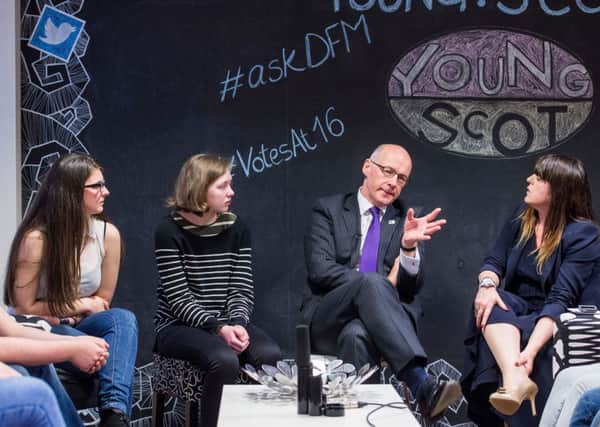Scott Macnab: Youngsters key to flourishing political future


It’s not that this group account for a major chunk of the electorate – perhaps just 3 per cent of voters overall. But it does provide parties the chance to capture the endorsement of youngsters casting their first vote and to establish an emotive bond which could build the foundations of support for generations to come.
For while politics remains a huge turn-off for many, all the evidence from 2014 showed that, from being turned off, the younger generation was as enthused as any group. Of the 109,593 youngsters aged 16 and 17 registered to vote, about 75 per cent of those turned out to cast their ballot. Importantly, 97 per cent of those said that they would vote again in future elections. The changing dynamics of modern communications is opening up a previously closed political worked to young Scots. The emergence of social media provides the opportunity to get instant involvement and contact with politicians and other key players. The Yes campaign particularly utilised this, viewing it as a key mechanism to overcome the perceived anti-independence bias in the more established media. Younger activists were at the heart of this Twitter and Facebook drive.
Advertisement
Hide AdAdvertisement
Hide AdSo will the addition of this tranche of teenage voters alter the face of the campaigns in the coming months? On the face of it, there’s no reason why it should. One of the most interesting findings to emerge from the post-referendum analysis was that the issues which interested younger voters were the same for adults - jobs and the economy. But --previous Holyrood election campaigns have been a mixed bag with issues like the constitution, the NHS and free care for the elderly all playing their part.
Not this time. Both Nicola Sturgeon and labour leader Kezia Dugdale have both pledged that schools and education – securing a better future for the younger generation – will be at the heart of their respective campaigns. Ms Dugdale’s first major manifesto pledge was also a direct pitch to young Scots as she pledged to provide up to £3,000 of help to make up the deposits for those trying to get onto the housing ladder – at a time when the number of first time buyers is starting to fall.
The enthusiastic role which 16 and 17-year-olds played in the referendum campaign helped fuel a real sense of political renewal across Scotlandand it brought the country closer than anyone expected to choosing its own path outside the United Kingdom. This saw more than 80 per cent of Scots vote in the referendum as the country was gripped by a campaign which dominated the news agenda for years in advance – the stakes could not have been higher on both sides. Holyrood elections, by contrast, tend to attract turnouts of barely 50 per cent, so it can only be hoped that the presence 16 and 17-year-olds on the voting roll can help maintain that flourishing political culture. If this drains away in the months ahead, all Scots would be losers.